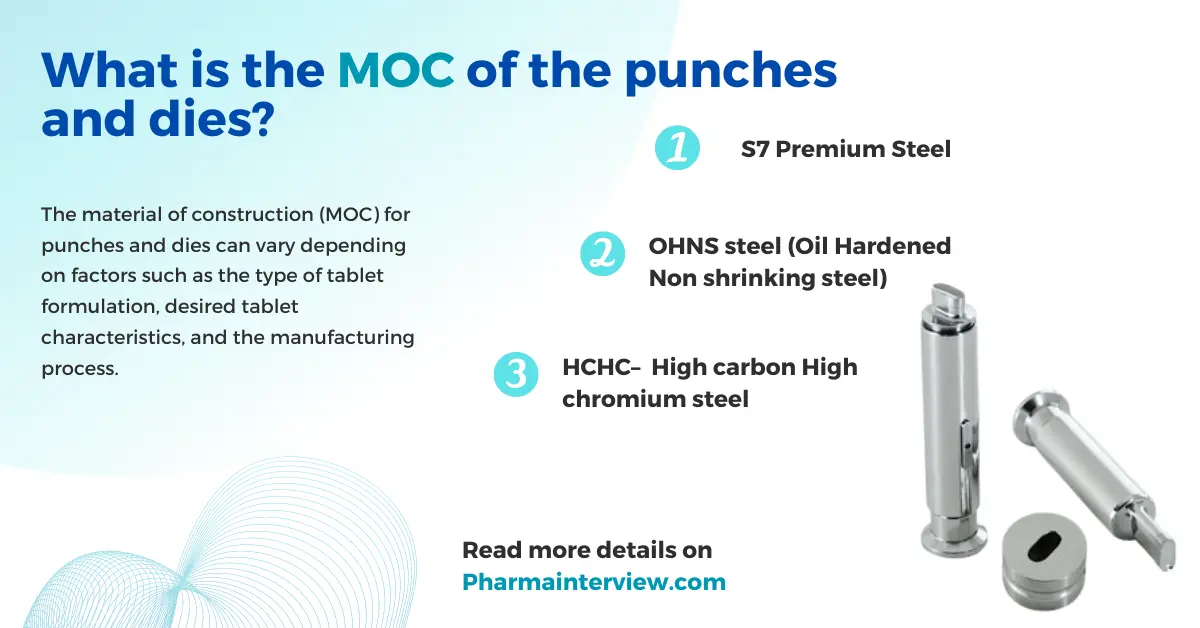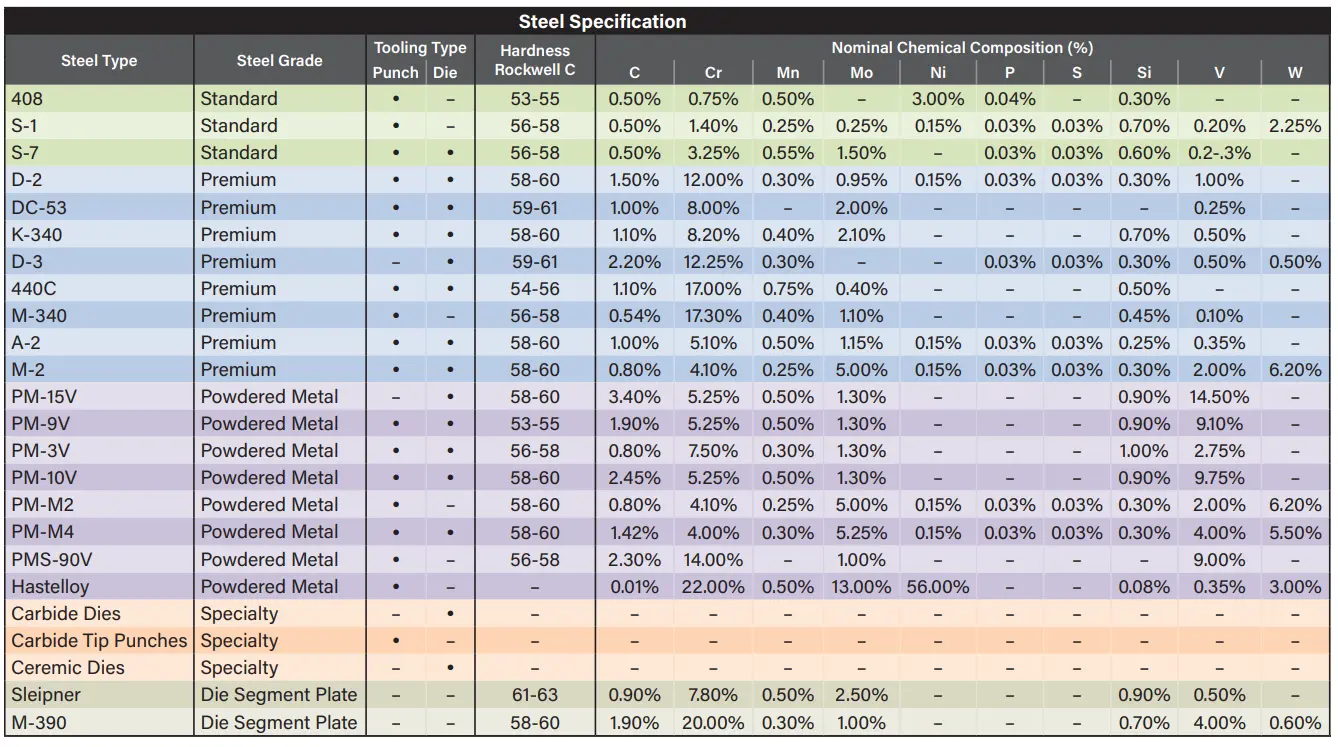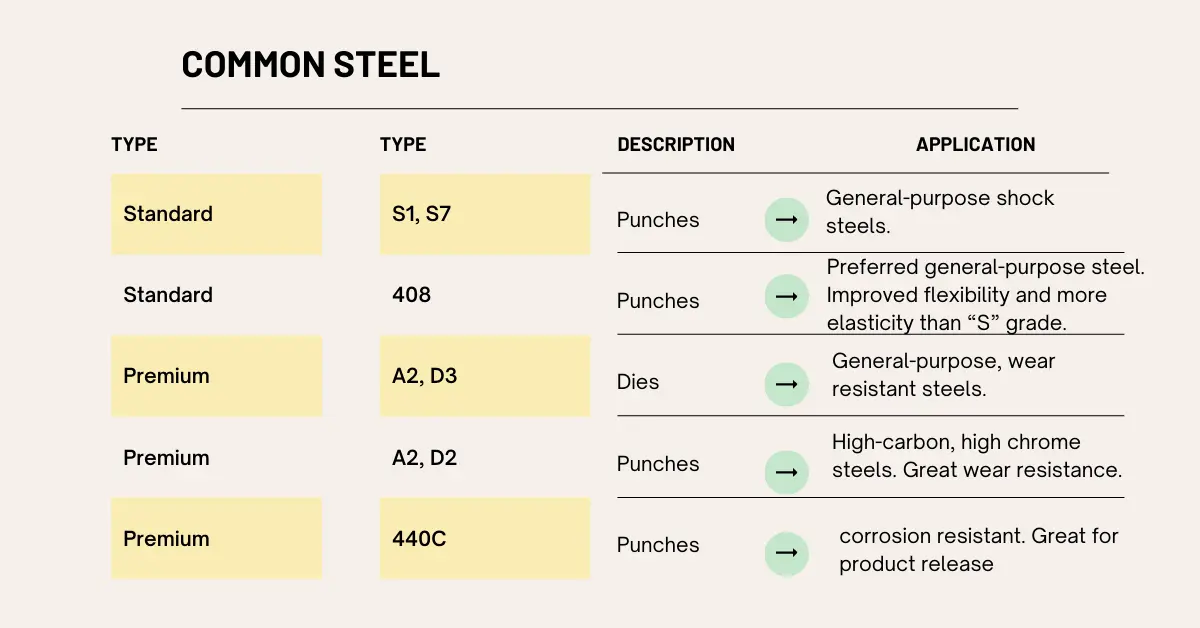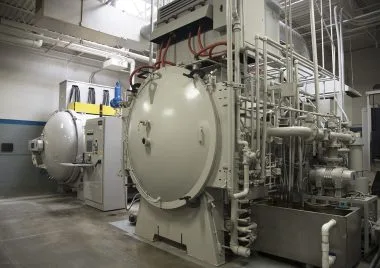In the pharmaceutical industry, punches and dies used in tablet compression machines are typically made from high-quality tool steels. The material of construction (MOC) for punches and dies can vary depending on factors such as the type of tablet formulation, desired tablet characteristics, and the manufacturing process.

The most commonly class of material used for making of punches and dies in pharmaceutical applications are following:
- Tool Steel (e.g., D2, S7, O1): Tool steels are widely used for punches and dies due to their excellent combination of hardness, toughness, and wear resistance. They can withstand the high compressive forces and abrasive nature of tablet compression processes.
- Stainless Steel (e.g., 420, 440C): Stainless steels are corrosion-resistant and have good mechanical properties, making them suitable for pharmaceutical applications. They are often used for punches and dies when corrosion resistance is required, such as in the presence of moisture or acidic formulations
- Carbide (e.g., Tungsten carbide): Carbide punches and dies offer superior wear resistance compared to tool steels or stainless steels. Tungsten carbide is a common choice for tablet compression applications where high production volumes or abrasive formulations are involved.
Material of construction (MOC) of punches
- S7 Premium Steel
- OHNS steel (Oil Hardened Non shrinking steel)
- HCHC Steel (High Carbon High Chromium Steel)
- OHNS (T): Oil Hardened Non shrinking steel (Tungsten) – AISI 01
S7 Premium Steel
S7 steel is a type of air-hardening tool steel that is commonly used in various industrial applications, including tool and die making, punches, chisels, and shear blades. It is part of the S-series of tool steels, which are known for their high impact resistance and toughness.
The composition of S7 steel typically includes the following elements:
- Carbon (C): 0.45% – 0.55%
- Chromium (Cr): 3.0% – 3.5%
- Manganese (Mn): 0.20% – 0.80%
- Silicon (Si): 0.20% – 0.50%
- Molybdenum (Mo): 1.30% – 1.60%
S7 steel is an air-hardening steel, meaning it develops its hardness properties through cooling in air rather than oil or water quenching. This makes it easier to work with compared to some other tool steels that require more rapid quenching methods.
The key properties of S7 steel include:
- Toughness: S7 steel is known for its excellent toughness, which allows it to resist chipping and breaking under high impact loads. This property makes it suitable for applications that require resistance to shock and impact.
- Wear Resistance: S7 steel offers good wear resistance, enabling it to withstand abrasive conditions and extend the tool life.
- Hardenability: S7 steel has good hardenability, meaning it can be hardened throughout its entire cross-section, making it suitable for applications that require uniform hardness.
- Machinability: S7 steel has fair machinability. It can be machined using conventional methods but may require slower cutting speeds and adequate cooling to prevent overheating.
OHNS steel (Oil Hardened Non shrinking steel)
OHNS steel, also known as Oil Hardened Non-Shrinking steel, is a specific grade of tool steel that has a standardized composition. The material of construction (MOC) for OHNS steel is as follows:
- Carbon (C): 0.85% to 0.95%
- Manganese (Mn): 1.20% to 1.50%
- Chromium (Cr): 0.20% to 0.40%
- Tungsten (W): 0.30% to 0.60%
- Vanadium (V): 0.10% to 0.25%
HCHC Steel (High Carbon High Chromium Steel)
HCHC steel, also known as High Carbon High Chromium steel, is a type of tool steel widely used in various applications.
- Carbon (C): Approximately 0.80% to 1.20%
- Chromium (Cr): Typically around 3.50% to 5.50%
- Manganese (Mn): Generally around 0.20% to 0.50%
- Silicon (Si): Typically between 0.10% to 1.00%
- Other elements: HCHC steel may contain trace amounts of phosphorus (P), sulfur (S), vanadium (V), and other impurities.
OHNS (T): Oil Hardened Non shrinking steel (Tungsten)
OHNS (T) steel, also known as Oil Hardened Non-Shrinking steel with tungsten, is a specific variant of OHNS steel that incorporates tungsten as an alloying element. It is sometimes referred to as AISI 01 steel. The composition of OHNS (T) steel typically includes the following elements:
- Carbon (C): Approximately 0.85% to 0.95%
- Manganese (Mn): Around 1.20% to 1.50%
- Chromium (Cr): Typically between 0.50% to 1.00%
- Tungsten (W): Generally around 0.40% to 0.60%
- Silicon (Si): Typically between 0.10% to 0.40%
Other elements present in OHNS (T) steel can include small amounts of phosphorus (P), sulfur (S), and trace impurities. The exact composition may vary slightly depending on the specific grade and manufacturer specifications.
OHNS (T) steel is valued for its excellent wear resistance, toughness, and hardness, making it suitable for various tooling and machining applications. It is often used for making punches, dies, cutting tools, and other high-strength components that require good dimensional stability.

Material of construction (MOC) of dies
- HCHC– High carbon High chromium steel – AISI D2.
- HCHC– High carbon High chromium steel – AISI D3.

Material of construction (MOC) of Turret
- Graphite casting iron
Material of construction (MOC) of Compression Change parts
- SS-316
- SS-316 L
- Brass
- Teflon
Punch tip coating
Punch tip coating is required to
- Improving Wear Resistance
- Improving Corrosion Resistance
- Improving Anti-stick Properties
Punch tip coating options to address different compression challenges:
- Hard chrome plating (HCP)
- Chrome nitride (CrN)
- Titanium nitride (TiN)
- PVD chrome (PCR)
- Titanium aluminum nitride (TAN)
Hard chrome plating (HCP)
- Hard chrome plating coatings improve the corrosion and wear resistance of the tooling and reduce the effect of product friction and adhesion on the tooling.
- Hard chrome plating coatings are suitable for tooling used on slightly abrasive, corrosive, or sticky materials.
Chrome nitride (CrN)
- Chrome nitride coatings exhibit the greatest corrosion resistance, very good adhesion properties, and good wear resistance.
- Chrome nitride coatings are suitable for tooling used on highly corrosive, very sticky, or moderately abrasive materials.
Titanium nitride (TiN)
- Titanium nitride coatings demonstrate high abrasion and wear resistance and better adhesion properties than FSG-HCP coatings.
- Titanium nitride coatings are suitable for tooling used on highly abrasive and corrosive materials.
PVD chrome (PCR)
- PVD chrome coatings offer greater wear resistance and better adhesion properties (i.e. products are less likely to stick to the surface) than HCP coatings and good corrosion resistance.
- PVD chrome coatings are suitable for tooling used on moderately abrasive, corrosive, and/or sticky materials.
Titanium aluminum nitride (TAN)
- Titanium aluminum nitride coatings have the best wear resistance.
- Titanium aluminum nitride coatings are suitable for tooling used on extremely abrasive materials, such as crystalline powders (e.g., salts or other minerals).
Punch tip embossing
Embossing is a technique used in the pharmaceutical industry for various purposes like branding and Identification, Tamper-Evidence, Anti-Counterfeiting, Accessibility for the Visually Impaired and Aesthetic Appeal.
Following are the example of punch tip embossing
- All type of letters
- Breaklines
- Notches
- Logos
Heat-Treating process
Steel quality is important in pharmaceutical compression machine. the heat-treating process is used for making High quality steel and consistence hardness thought out the batch.

People also read:
Tablet Tooling in Pharma : An Overview
Blend Uniformity (BU) analysis in Pharmaceutical industry
FAQ – MOC of punches and dies
What is the die and punch manufacturing process?
The die and punch manufacturing process typically involves steps like design, tool fabrication, setup, application of force, deformation or cutting and removal and inspection.
What material is a tablet die punch made of?
Tablet punches and dies are made of high quality alloy tool steels. for example S7 Premium Steel, OHNS steel (Oil Hardened Non shrinking steel), HCHC Steel (High Carbon High Chromium Steel), OHNS (T): Oil Hardened Non shrinking steel (Tungsten).
What material is used for dies?
HCHC – High carbon High chromium steel- AISI D2, D3
What is the working length of a punch?
This distance between the deepest point of the punch’s tip cup and the outside surface of the punch’s head is called as working length of a punch.